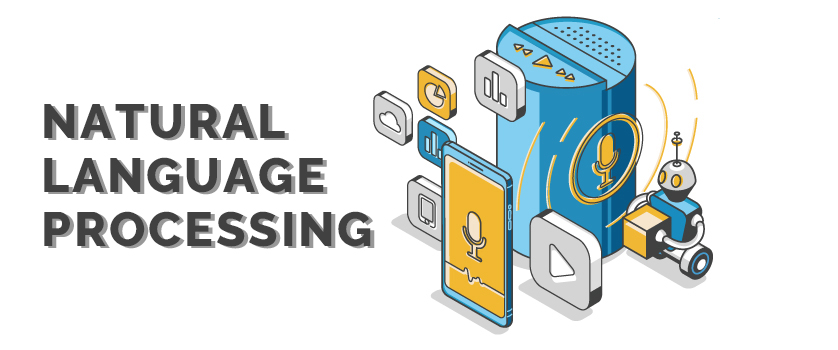
Anshul Jain
22 Apr 2020
Ever since the introduction of Artificial Intelligence (AI), machines and technology have gone through drastic advancements, with new and quality inventions taking over our day-to-day lives. From Siri and Cortana to Alexa, Echo, and more, intelligent machines and applications are helping humans perform tasks that were earlier considered to be time-consuming and difficult. In short, AI, along with machine learning, deep learning, neural network, and other such technologies, is successfully building software and applications that can think and work like humans without fatigue and in a consistent, unbiased way. Among these, Natural Language Processing is a prominent technology that has prompted a rise in software and applications that are capable of understanding human languages.
What is Natural Language Processing?
A subfield of Artificial Intelligence, Natural Language Processing or NLP deals with linguistics and is focused on enabling computers to understand, interpret, and process human languages like English, French, Hindi, etc. NLP achieves this by extracting data and meaning from human languages and making decisions based on the available information, which promotes smooth interactions between humans and computers. It helps program computers, enabling them to process and analyze large amounts of natural language data effectively.
Moreover, to bridge the gap between human communication and computer understanding, Natural Language Processing NLP draws from a variety of disciples, like computer science, computational linguistics, etc., and is combined with text analytics and natural language understanding (NLU) for even more accurate results. Further, it makes it possible for developers to organize and structure knowledge to perform tasks like translation, summarization, topic modeling, word segmentation, speech recognition, etc.
What is Natural Language Processing With an Example?
Working behind the scenes, natural language processing handles a variety of day-to-day functions. It is the underlying mechanism behind predictive texts, email filters, smart assistants, etc. Other prominent uses of Natural Language Processing are:
- Email Assistant: Auto-correct, grammar & spell checks, auto-complete, as well as tone detectors are all functions enabled by NLP.
- Machine Translation: Machine translation, like Google Translate, is linguistically and grammatically more accurate due to the application of NLP.
- Text Analytics: NLP is being used to convert unconstructed data into a meaningful one through analysis.
- Search Results: Search engines are using NLP to improve the search and get relevant results based on user search behavior.
This list of natural language processing examples is non-exhaustive and is bound to increase in the coming years, with businesses and industries embracing it to further automate tasks, improve communication, etc.
Components of Natural Language Processing:
Before we move on to understanding other elements of natural language processing, we must comprehend its basic components. Natural Language Processing is an amalgamation of different components that are used to understand human languages, as they are spoken, as well as provide data, solutions, etc. that embodies the comprehended meaning. These components of NLP are:
- Natural Language Understanding (NLU): Also known as Natural Language Interpretation (NLI), NLU is a subtopic of natural language processing. It deals with machine reading comprehension and is used to interpret the meaning the user communicates.
- Natural Language Generation (NLG): Another vital component of natural language processing, NLG, is a software process used to transform structured data into natural language. It helps extract content from the data available.
- Pragmatic Analysis: Pragmatic analysis in NLP is used for abstracting and deriving the purposeful use of the language in situations where world knowledge is required. It uses the content of the utterance and deals with its intentions, such as criticize, promise, inform, request, etc.
- Semantic Analysis: It helps draw the exact meaning from the text. From providing context to language to identifying the text elements and assigning them to their logical and grammatical roles, semantic analysis plays a prominent role in NLP.
- Sentiment Analysis: Uses NLP, text analysis, computational linguistics, and biometrics to perform contextual mining of text, which helps identify and extract whether the underlying sentiment is positive, negative, or neutral.
- Syntactic analysis: Also known as parsing or syntax analysis, syntactic analysis analyzes a string of symbols, either in natural or computer language, or data structure, conforming to the rules of a formal grammar. Its purpose is to draw and extract meaning, report any syntax errors, recover from commonly occurring errors, etc.
- Entity extraction: Entity extraction, entity name extraction or entity recognition, is an information extraction technique that seeks to locate and classify named entity in unstructured text.
- Text Preprocessing: Another important component of NLP tasks, text preprocessing transforms the text into a more comprehensible form, which enables machine learning algorithms to perform better.
Each of these components is an integral part of natural language processing and is used to make human to computer interaction hassle-free and effective.
Natural Language Processing Techniques:
Nowadays, communicating with machines through natural language interfaces like Siri and intelligent assistants like Alexa is extremely common, as they allow us to get solutions quickly, without investing in extensive efforts. However, to accomplish real-world tasks, NLP uses two techniques:
1. Syntax Analysis:
An important component of linguistics, Syntax makes sure the arrangement of words in a sentence is grammatically accurate. Advancing this concept, syntax analysis in natural language processing helps assess how the natural language aligns with the grammatical rules of the required language. To achieve this, syntax analysis further uses a range of techniques:
- Lemmatization.
- Parsing.
- Sentence Breaking.
- Part-of-Speech tagging.
- Word Segmentation.
- Morphological Segmentation.
- Stemming.
2. Semantic Analysis:
Semantic Analysis is another important technique used for completing Natural Language Processing tasks. It refers to the meaning that is conveyed by a text, which in NLP is achieved through computer algorithms. These algorithms understand the meaning and interpretation of the words as well as how they are structured. Like syntax analysis, the semantic analysis also uses various techniques to accomplish this task, like:
- Lexical Semantics.
- Distributional Translation.
- Optical Character Recognition.
- Recognizing Textual Entailment.
- Sentiment Analysis.
- Topic Segmentation.
- Word Sense Disambiguation.
What are the Steps of Natural Language Processing?
A task performed by Natural Language Processing involves eight (8) crucial steps, each of which is focused on different aspects of assessing a sentence. These steps are:
- Sentence Segmentation:The process is initiated by breaking the piece of text into various sentences.
- Word Tokenization:After sentence segmentation, the sentence is further divided into individual words, which are known as tokens. This includes both words as well as the punctuation used in the sentence.
- Predicting Parts of Speech:Once the words are tokenized, NLP predicts the parts of speech for each token, whether they are noun, verb, pronoun, adjective, etc.
- Lemmatization:Here the focus is on finding the most basic form or root form of the word and feeding it to the model accordingly. This prevents the system from confusing two words, like Talk & Talking, Play & Playing.
- Identify Stop Words:Words like ‘a’, ‘and’, ‘the’, and more are considered stop words by NLP and are removed during the process. However, they are used to understand the dependency of the tokens.
- Dependency Parsing & Finding Noun Phrases:It involves identifying the relationship between the words in the sentence and how they are related to each other. This is accomplished through a parsing tree, where the main verb in the sentence acts as the root. Moreover, words that share a similar idea are grouped together here.
- Named Entity Recognition:After identifying the relationship between words, named entity recognition begins its work by looking for how a word is placed in a sentence and using statistical models to identify what kind of word actually it is.
- Coreference Resolution:Finally, the system is taught the difference as well as the context of pronouns used in the sentence to prevent confusion. With this, the process comes to an end and the appropriate solution is presented by the system.
Now that we have covered some of the important aspects of NLP, let us move on to answering Where is natural language processing is used?
Natural Language Processing Use Cases:
No longer a technology of the future, natural language is currently everywhere, streamlining business processes and offering a range of potential benefits across diverse use cases. From healthcare to government, industries are leveraging the capabilities of this technology to better reach users. Some of these use cases of Natural Language Processing are:
- Chatbots:One of the most popular uses of NLP, chatbots are everywhere and helping bridge the gap between users and organizations. NLP provides context and meaning to text-based user inputs and enables the chatbots to understand user’s messages, queries, etc. and respond with the best and most appropriate response.
- Creditworthiness Assessment:The impact of NLP can be felt even in the banking industry. Banks in developing countries are now using NLP to assess the creditworthiness of their clients, even if they have little or no credit history. NLP algorithms analyze client variables like geolocation data, browsing behavior to derive insights and make accurate assessments.
- Healthcare:The healthcare industry is another area dominated by natural language processing, with it being implemented to handle the surge in clinical data, improving clinical documentation, patient-provider interactions, document categorization, information extraction, etc.
- Marketing Intelligence: NLP Models and tools are used in marketing to help industries stay relevant and abreast of the latest marketing trends. Moreover, it is helping companies analyze competitors marketing strategies, which is further helping them finetune their strategies.
- Advertising:The realm of advertising is witnessing the greatest advancement today due to Artificial Intelligence and Natural Language Processing. Organizations are leveraging NLP capabilities like sentiment analysis, voice research, automated summarization, machine translation, etc. to deliver relevant, localized, and culturally appropriate advertisements that resonate with the audience.
- Social Media:Another great example of the NLP use case is social media, which is being integrated with NLP by organizations to track conversions online, gain insights into user behavior, as well as understand what customers are saying.
Advantages & Disadvantages of Natural Language Processing:
Advantages:
From helping computers to understand human speech and language to improving the accuracy of documentation, identifying the most pertinent information from large databases, etc., the benefits of natural language processing are innumerable, like:
- Helps computers imitate human speech and form naturally-flowing sentences.
- NLP makes sentiment analysis easier.
- Removes language barriers.
- Useful for personal assistants like Siri.
- It provides human-to-machine interactions with a personal touch.
- Enables consistent language-based data comparison, without any bias & fatigue.
- Improves the accuracy and efficiency of documentation.
- NLP allows organizations to use chatbots for customer support.
- Enables users to get direct answers to their queries immediately.
Disadvantages:
Natural Language processing is helping advance a range of technologies and software, like social listing tools, chatbots, machine learning, etc., however, there are some disadvantages associated with this technology, a few of which are:
- It requires a complex query language, as machines won’t be able to provide solutions to ambiguous queries.
- NLP lacks a user interface, which prevents interaction between the system and users.
- It is programmed for specific tasks and can’t adapt to new domains.
- Requires clarification dialogues.
- May provide solutions that may not show context.
- It is unpredictable.
Natural Language Processing Challenges:
The development of natural language processing applications is a challenging feat, as computers are dependent on human programming languages, which enables them to understand human language/speech. Moreover, for NLP to work properly, the program, as well as the human command needs to be precise, unambiguous, highly structured and clearly enunciated. That’s not it, there are various other challenges associated with this technology, some of which are mentioned below:
- Lacks understanding of context.
- It does not have memory.
- Misspellings in entity extraction
- Tackling false positives becomes challenging.
- Multiple intents in one question can lead to confusion.
- Linking different components of vocabulary.
Difference between Speech Recognition & Natural Language Processing:
While researching NLP, the most common question we came across was Is speech recognition natural language processing? This makes it crucial for us to differentiate the two from one another. Though two important components of AI, Speech Recognition and Natural Language Processing, are vastly different from one another and are used together to create advanced and more accurate intelligent machines. However, their similarities end here.
Speech Recognition
- A subfield of computational linguistics that incorporates knowledge & research in linguistics, computer science, & electrical engineering fields.
- Also known as Automatic Speech Recognition (ASR), Computer Speech Recognition or Speech to Text (STT).
- The focus of speech recognition is on recognizing tones and phonetics, such as female or male, or ascent.
- Identifies spoken words and phrases, converting them into a machine-readable format.
- Uses various algorithms through acoustic and language modeling.
- It is used in machines for setting up reminders, sending emails, playing games, checking weather reports, etc.
Natural Language Processing
- Natural Language Processing is a subfield of linguistics, computer science, information engineering, and artificial intelligence.
- Concerned with the interactions between computers and human (natural) languages.
- The focus of NLP is on appropriate wording and word sequencing to make it as natural as possible.
- Identifies grammar, semantics, pragmatics, parsing text, morphology
- Uses Natural Language Understanding (NLU) & Natural Language Generation (NLG).
- It is used in machines and applications like virtual assistants, personal assistants, etc.
Conclusion:
NLP machine learning and AI are the emerging technologies of today that are revolutionizing the way industries work world-wide. Natural Language Processing is making machines capable of meaningfully interpreting and acting on human language models and inputs, whereas, Natural Language Processing models and Natural Language Processing Types are further making this transition smooth by maximizing productivity, streamlining operations, delivering accurate insights, and allowing organizations to keep up with the competition. In short, Natural Language Processing is making processes that were earlier termed as cumbersome hassle-free and agile.




